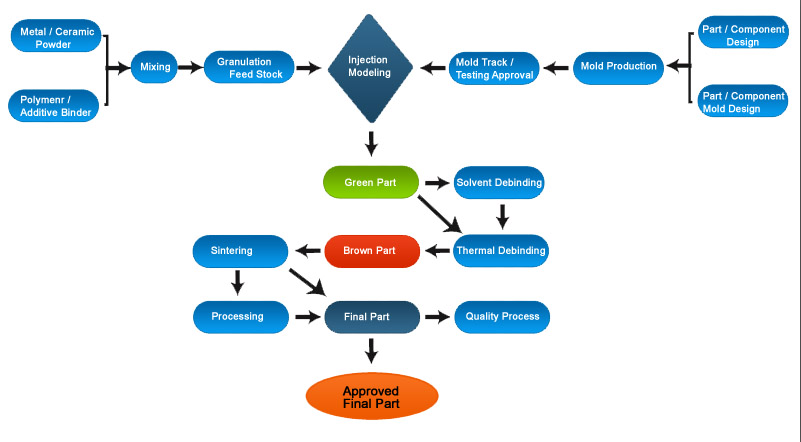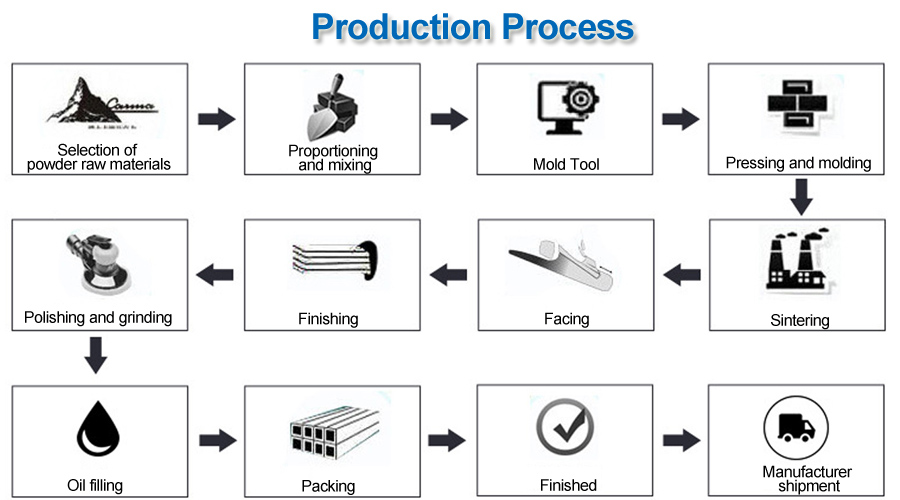MIM Manufacturing Process
Harber offers a wide range of engineering solutions and process methods to aid in the manufacture of your metal component designs. We also provide various added value processes such as Soldering, Assembly Work, Spot Welding & traditional welding as well as a wide range of plating finishes including Silver, Gold, Tin, Nickel, Alocrom & Anodising that are all offered.
We serve industries within the Aerospace, Automotive, Creative Arts, Defence Projects, Electronics Devices, Broadcast Equipment, Instrumentation Technology, Scientific Devices, Medical Devices, Telecommunications, Consumer Goods, Oil & Gas & Renewable Energies market sectors, and have vast experience in project management with major blue chip companies, 2nd & 3rd tier supply chains through to much smaller independent and stand-alone businesses both for research and development projects or major volume production.
Harber Metal Injection Molding Process
The solid powder is uniformly mixed with an organic binder, granulated and then injected into the mold cavity by injection molding machine under heated plasticized condition (~150°C) to solidify the molded part, and then the binder in the molded part is removed by chemical or thermal decomposition, and finally the final product is obtained by sintering and densification. Compared with the traditional process, it has the characteristics of high precision, uniform organization, excellent performance, low production cost, etc. Its products are widely used in electronic information engineering, biomedical equipment, office equipment, automobiles, machinery, hardware, sports equipment, clocks and watches, weapons and aerospace and other industrial fields. Therefore, the international bragging that the development of the technology will lead to a revolution in parts forming and processing technology, known as "today's hottest parts molding technology" and "the 21st century forming technology".


Injection Molding Process Dynamic graph
Why choose Metal Injection Molding technology (MIM)?
Net Shape Technology
Net forming, also known as precision molding, is a molding technology that allows a part to be used as a mechanical component after it has been molded with only a small amount of machining or no further machining. Net Forming is an advanced manufacturing process that controls the flow and deformation of material to achieve precise shapes and sizes of products. It is widely used in various fields, such as automotive It has a wide range of applications in various fields, such as automotive manufacturing, aerospace, electronic equipment, etc.
1). Cost Effective-MIM parts (Metal injection molding parts) have an significant advantage in producing small, highly complex metal components. While conventional technologies such as PM, machining or casting can't produce it or its cost is very high.
2). Part weight is 1~100g.
3). Part thinckness is thin and need high strength which PM and precision casting can't manufacture.
4). MIM can process those metal parts which PM can't achieve better strength and casting can't meet higher tolerance.
Our Production Process
Our Sintering Process
The molded metal component is called the "brown part", the degreased brown billet is placed in a high temperature, high-pressure controlled furnace. Under gas protection, the brown body is slowly heated to near its melting point to remove residual binders, ensuring complete removal of all remaining binders. Once the binders are completely removed, the "brown part" is heated to a very high temperature, causing the particles to fuse together and eliminate the gaps between them. The "brown part" shrinks directionally to its design size and transforms into a dense solid, resulting in the final product.
During the sintering process, approximately 15% overall shrinkage of the "brown part" occurs. Learn More>>
Metal Injection Molding Process FAQ
Does the parts shrink during the removal of binders?
No, the volume of the parts does not change during the debinding process. However, there is a 20% shrinkage of the parts during sintering.
How does MIM differ from conventional powder metallurgy processes?
Traditional powder metallurgy (PM) involves pressing coarse metal powders into a fixed shape under high pressure in a unidirectional manner to produce moderately complex components. Typically, the density values produced by this method are between 80-90%, limiting the physical properties of the alloys if not further improved during sintering. MIM, on the other hand, allows for the production of highly complex products due to the flexibility of fine metal powders combined with high-temperature sintering, achieving very high densities similar to precision materials.
Is the metal melted during the molding process?
No, only the binder is melted to allow the powders to flow like a plastic material. Cooling the binder gives the parts a certain degree of strength. Subsequently, the parts undergo sintering to achieve high density to meet their mechanical performance requirements.
How does the MIM process work?
Fine metal powders are combined with a binder to create a feedstock material. When heated, this material becomes a viscous paste, which is then injection molded under high pressure into the desired shape. After cooling, it is removed from the mold and undergoes processing
What is the density and strength of MIM products?
Typical MIM products have a theoretical density of over 98%. The specific density characteristics depend on the choice of material, but they are very close to those of precision materials.
Do parts shrink during the removal of binders?
No, the volume of the parts does not change during the debinding process. However, there is about a 20% shrinkage of the parts during sintering.
How does MIM differ from conventional powder metallurgy processes?
Traditional powder metallurgy (PM) involves pressing coarse metal powders into a fixed shape using unidirectional high pressure to produce moderately complex components. Density values produced by this method typically range from 80-90%, limiting the physical properties of alloys if further density improvement is not achieved during sintering. MIM, on the other hand, leverages the flexibility of fine metal powders combined with high-temperature sintering to achieve very high-density final products. This similarity to precision materials enables MIM products to exhibit similar characteristics.
Is the metal melted during the molding process?
No, only the binder is melted to allow the powder to flow like plastic. Cooling the binder imparts some strength to the parts. Subsequently, sintering at high temperatures achieves high density in the parts to meet their mechanical performance requirements.
How does MIM work?
Fine metal powders are combined with a binder to create a feedstock material. When heated, this material becomes a viscous paste, which is then injection molded under high pressure to form the desired shape. After cooling, it is removed from the mold, and processing is carried out to remove the binder component (referred to as debinding). The final step, sintering, involves placing it in a controlled high-temperature environment, where the metal powder melts and coalesces into a dense solid.
What is MIM technology?
MIM is a manufacturing technology that combines injection molding and powder metallurgy.
Why would you use MIM?
MIM has advantages in producing intricate and highly complex parts that are difficult to manufacture using traditional machining or casting techniques, often at a lower cost.
What materials can be used in MIM?
Almost all metal alloys can be used in MIM processes, with typical alloys including high-strength steels, nickel-based stainless steels, and superalloys. Other materials processed include refractory alloys, titanium, and copper alloys, while low-melting-point alloys like brass, bronze, and zinc-aluminum are uneconomical for MIM processing. For more details, you can refer to Harber's material selection chart for the entire process.
What are the effective pathways to achieve MIM benefits?
Applying MIM technology during the early stages of product development is an effective pathway to realizing MIM benefits. Harber can assist in applying MIM technology to both new products and existing traditional metal forming products.
MIM have any limitations?
Like any other technology, MIM Technology has its limitations. The general maximum weight limit for products is around 240 grams (typically kept under 50 grams for economic reasons). Certain geometric features can also present challenges (extremely thick or thin cross-sections). Harber will advise on suitable design solutions for your product.
What tolerances can be achieved?
Typical MIM tolerances range from 0.3% to 0.5%. However, tolerances largely depend on the geometric characteristics of the product. Tolerances beyond what MIM technology can achieve can be realized through machining. GIAN will help you analyze and provide a comprehensive selection to meet your product requirements.
What equipment is used in the process?
Harber utilizes advanced equipment with controllers to ensure high precision outputs. Harber has established strategic partnerships with equipment suppliers from many European and American countries to customize equipment with special service capabilities.
Can MIM undergo heat treatment or plating?
MIM parts, like traditionally machined products, can undergo heat treatment, plating, machining, or forging. Harber has its own heat treatment and plating equipment to provide complete finished components.
Contact Harber for Complex&Precision Metal Manufaturing Today
We would love the opportunity to earn your business! Come visit our factory to see how we give our customers a better experience.












